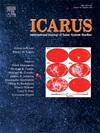嵌入土星环的小卫星扰动产生的间隙边缘结构的全局n体模拟II:卫星轨道偏心率和倾角的影响
IF 2.5
2区 物理与天体物理
Q2 ASTRONOMY & ASTROPHYSICS
引用次数: 0
摘要
小卫星“潘”和“Daphnis”嵌在土星环中,在环的边缘打开了一个清晰的缝隙,卫星尾迹在缝隙边缘。此外,在达芙妮的情况下,在卫星尾迹中也观察到明显的垂直壁结构在环上投下阴影。在我们之前的论文(鸟居,N., Ida, S., Kokubo, E., Michikoshi, S.)[2024]。Icarus, 425, 116029),我们通过全局三维n体模拟发现,环粒子与卫星相遇激发的横向本轮运动通过粒子之间在卫星尾迹波前的倾斜物理碰撞转化为垂直运动。为了突出这种动态,Torii等人(2024)考虑了圆形(es=0)和共面(is=0)卫星轨道,其中es和is分别是卫星轨道偏心率和倾角。然而,达芙妮有不可忽略的偏心和倾角。本文采用卫星轨道非零e或非零e的全局三维n体仿真,研究它们对间隙边缘结构的影响。我们发现卫星偏心对卫星尾迹和间隙边缘垂直壁面的影响都很重要。卡西尼观测到的非正弦锯齿状卫星尾迹和方位角上更局部化的垂直壁面在详细结构和空间尺度上同时重现。它们都是周期性变化的,因为伪中心和周中心之间的卫星偏移。外(内)环上的粒子在离中心(中心)最近的地方与卫星接触时被激发得最高。由于环粒子的激发态偏心率通过物理碰撞转化为倾斜度,偏心率最高的粒子转化最活跃,从而形成方位上更局部化的垂壁结构。在采用希尔尺度时,在卫星偏心率与达芙尼相当的情况下,预测的最高垂直壁高度是卫星希尔半径的0.2倍,这是圆形卫星轨道情况下获得的高度的两倍,在数量上与卡西尼号的观测结果更加一致。卫星倾斜轨道的模拟结果表明,粒子碰撞产生的局部垂直壁在卫星波前持续存在,并与卫星面外扰动引起的全局弯曲波叠加在一起。这些结果表明,观测到的垂直壁面实际上是由卫星尾迹通过粒子间碰撞转化为垂直运动形成的,而不是由卫星在倾斜轨道上的面外扰动形成的。本文章由计算机程序翻译,如有差异,请以英文原文为准。
Global N-body simulation of gap edge structures created by perturbations from a small satellite embedded in Saturn’s rings II: The effect of satellite’s orbital eccentricity and inclination
Small satellites, Pan and Daphnis, are embedded in Saturn’s rings and opening a clear gap with satellite wakes at the gap edges. Furthermore, in the case of Daphnis, pronounced vertical wall structures casting shadows on the rings are also observed in the satellite wakes. In our previous paper (Torii, N., Ida, S., Kokubo, E., Michikoshi, S. [2024]. Icarus, 425, 116029), we found through global 3D N-body simulation that the ring particles’ lateral epicycle motions excited by an encounter with a satellite are converted to the vertical motions through oblique physical collisions between the particles at the wavefronts of satellite wakes. In order to highlight this dynamics, Torii et al., (2024) considered the circular () and coplanar () satellite orbit, where and are the satellite orbital eccentricity and inclination, respectively. However, Daphnis has non-negligible eccentricity and inclination. In this paper, we perform a global 3D N-body simulation with non-zero or non-zero of the satellite orbit to investigate how they affect the gap edge structures. We found that the effect of satellite eccentricity is important both in the satellite wakes and the vertical walls at the gap edges. The non-sinusoidal sawtooth-like satellite wakes and azimuthally more localized vertical walls observed by Cassini are simultaneously reproduced in the detailed structures and spatial scales. Both of them periodically vary due to the satellite excursions between the apocenter and the pericenter. The ring particles in outer (inner) rings that undergo closest encounters with the satellite near the apocenter (pericenter) are excited the most highly. Because the excited eccentricities of the ring particles are converted to the inclinations through physical collisions, the conversion is the most active for the particles that acquire the highest eccentricities, resulting in the azimuthally more localized vertical wall structures. The predicted height of the tallest vertical walls is times the satellite Hill radius in the case of the satellite eccentricity comparable to Daphnis when adopting Hill scaling, which is twice as much as the height obtained in the case of the circular satellite orbit and is quantitatively more consistent with the Cassini observation. The simulation with the inclined satellite orbit reveals that the local vertical walls created by the particle–particle collisions persist at the satellite wavefronts and are superposed with the global bending waves induced by the satellite out-of-plane perturbations. These results show that the observed vertical walls are actually formed by the satellite wakes followed by their conversion to the vertical motions through inter-particle collisions, rather than by the out-of-plane perturbation from the satellite in an inclined orbit.
求助全文
通过发布文献求助,成功后即可免费获取论文全文。
去求助
来源期刊

Icarus
地学天文-天文与天体物理
CiteScore
6.30
自引率
18.80%
发文量
356
审稿时长
2-4 weeks
期刊介绍:
Icarus is devoted to the publication of original contributions in the field of Solar System studies. Manuscripts reporting the results of new research - observational, experimental, or theoretical - concerning the astronomy, geology, meteorology, physics, chemistry, biology, and other scientific aspects of our Solar System or extrasolar systems are welcome. The journal generally does not publish papers devoted exclusively to the Sun, the Earth, celestial mechanics, meteoritics, or astrophysics. Icarus does not publish papers that provide "improved" versions of Bode''s law, or other numerical relations, without a sound physical basis. Icarus does not publish meeting announcements or general notices. Reviews, historical papers, and manuscripts describing spacecraft instrumentation may be considered, but only with prior approval of the editor. An entire issue of the journal is occasionally devoted to a single subject, usually arising from a conference on the same topic. The language of publication is English. American or British usage is accepted, but not a mixture of these.
 求助内容:
求助内容: 应助结果提醒方式:
应助结果提醒方式:


